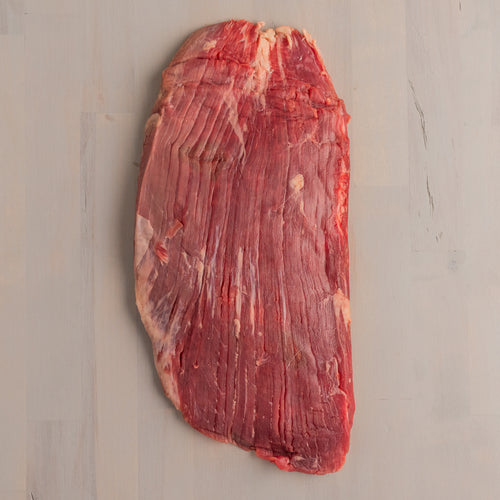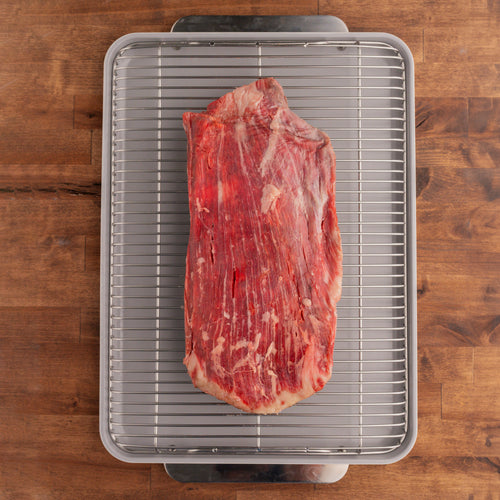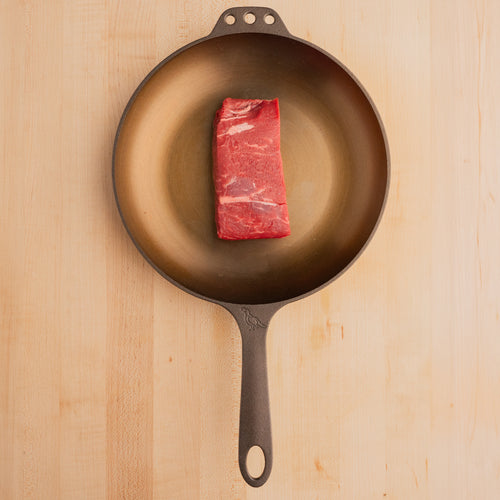
Why It’s Important to Cut Against the Grain
Why is it important to cut meat against the grain? Cutting against the grain shortens the muscle fibers of a steak and makes it tender. This prevents the steak texture from being tough or chewy. Understanding how to cut meat against the grain is an important technique to get the best eating experience from steaks, chops and roasts.
Cutting against the grain is simple. Find the direction of the muscle fibers, then slice at a 90° angle. Read on to learn more about this important meat carving skill.
Why is it Important to Cust Against the Grain?
Cutting meat against the grain shortens the muscle fibers and provides a more tender and delicious eating experience. Conversely, if meat is cut in the same direction as the grain, the muscle fibers remain long which makes for a chewy bite.
Recipes often end with a note to “slice against the grain.” Cutting meat against the grain is a crucial culinary technique to serve tender steaks, chops and roasts. Fortunately, it’s easy to gain expertise so you can be a meat cutting pro at home.
What is the Grain in Meat?
Just like the grain in a piece of wood, each cut of meat has its own grain. A steak, roast or any type of meat is made up of an array of muscle fibers lined up together in bundles. The grain is the direction these muscle fibers are aligned.
- Keep in mind the grain is not:
- Grill marks on a steak.
- Lines where the meat was folded before it’s packaged.
- Natural materials like swaths of fat or connective tissue.
How do You Find the Grain in Meat?
Finding the grain of a cut of meat is easiest when it is raw. Place the steak, chop or roast on a flat surface and do a quick inspection. Find the direction of the muscle fibers and you can easily determine the grain. Knowing the direction of the grain prior to cooking is helpful when the finished product is on the cutting board.
The flank steak is a cut with a grain that is easy to find. This steak has distinct coarse muscle fibers that run in the same direction for its entire length.
Tender, fine grained steaks, including the filet mignon, ribeye and strip steak, have already been cut against the grain. The muscle fibers of these steaks run from the front to the back of the animal. Cutting steaks from these larger subprimal pieces requires slicing against the natural grain.
For example, the filet mignon is cut from the psoas major, a long muscle that rests underneath the loin or ribeye. When cut into steaks, each filet is cut 90° against the grain and the muscle fibers are shortened. The tenderloin steak, or filet mignon, is the most tender steak and produces a fork-tender steak regardless of how it is cut when served.
Here is a filet mignon that was cut from the full tenderloin. The strands of muscle are thin, which makes for a naturally tender steak. Each steak has already been cut against the long grain which makes it difficult to find a grain in the cross section.
The grain doesn’t always flow in the same direction throughout an entire cut. The tri tip is an example of a single item where the grain lines up in multiple directions.
How to Cut Meat Against the Grain
First find the grain of the cut you are slicing. The concept of “against the grain” is to slice at a 90° angle, or perpendicular, to the direction of the muscle fibers.
It really is that simple. Once you’re aware of the presence of the grain, it’s much easier to find it and slice each steak or roast properly.
Here are some examples:
- Cutting a flank steak against the grain is straightforward. The large grain is easy to see, even when the steak comes off the grill. Simply cut along the short side and get ready to enjoy a tender bite.
- We know the filet mignon is already cut from the full tenderloin, so the muscle fibers are shortened and there’s not a grain when looking at the steak. There is a way to continue to cut against the grain and maximize tenderness.
Cut the steak diagonally at a 45° angle. This continues to cut against the grain by shortening the muscle fibers to provide a tender bite.
-
Ribeyes and New York strips are also cut from subprimals against the grain of the longissimus dorsi (Ribeyes also include the complexus muscle.) The long muscle fibers are shortened when cut into steaks, just like the filet mignon. For optimal tenderness, use the same technique of cutting the steak diagonally at a 45° angle.
The New York strip has a grain that runs across the short side of the steak. For the most tender eating experience, cut against this grain diagonally.
- The tri tip is a larger cut where the grain changes direction from one end to the other.
To start, locate the grain. In the photo, look at the left side. The grain runs from left to right. About halfway, the grain changes from top to bottom.
Next, cut the tri tip into three pieces. Make the first cut where the grain changes direction, as seen in the photo.
Make the second cut in the same direction of the grain.
After separating the tri tip into three pieces, cut each piece across the grain.
For the section on the left, continue to slice the roast in the same direction as the initial slice.
For the sections on the right, rotate each piece 90°. Slice each section across the grain.
The entire tri tip is now cut against the grain into tender slices and is ready to serve.
With a little practice, it’s easy to find the grain in any cut of meat. Regardless of the steak or roast you are serving, cutting against the grain results in serving Snake River Farms American Wagyu beef in the most tender and delicious manner possible.







